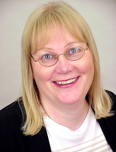Artificial
Intuition
A New Possible Path To
Artificial Intelligence
by Monica Anderson
Monica Anderson

I have been interested in the quest for computer based cognition since college, and ever since then I have sought out positions with startup companies that have used cutting-edge technologies that have been labeled as "AI". However, those that worked well, such as expert systems, have clearly been of the "Weak AI" variety. In 2001 I moved from using AI techiques as a programmer to trying to advance the field of "Strong AI" as a researcher. I am the founder of Syntience Inc., which was established to manage funding for my exploration of this field.
I have originated several ideas that I (intend to) discuss on this site and elsewhere. I'm currently exploring these ideas using a "personal supercomputer" I built for the purpose (four cores using Opteron 2220, and 32GB RAM). In my spare time, I enjoy being a member of the Bay Area AI Meetup group.
I am in the process of developing a series of talks on this topic. The first one is ready and covers roughly what this site covers. Talks beyond that are either more technical or dip into Philosophy and Epistemology to support the theory. Details about my algorithm are proprietary and will currently only be discussed under NDA. If you would like me to give a talk, please get in touch with me.
Competence and Track Record
... depending on how complex and unique a computer language has to be in order to count as "a separate language"
... depending on how well you must know a language to qualify as "knowing it".
I have a Master's degree in Computer Science from Linköping University in Sweden, but I have been working in Silicon Valley for many years and I am a US citizen. I have created three expert systems for Cisco Systems for product configuration verification; I have co-designed systems to automatically classify documents by content; I have (co-)designed and/or (co-)written LISP interpreters, debuggers, chat systems, OCR output parsers, visualization tools, operating system kernels, MIDI control real-time systems for music, virtual worlds, and peer-to-peer distributed database systems. I was Manager of Systems Support for Schlumberger Palo Alto Research. I have worked with robotics, industrial control, marine, and other kinds of embedded systems. I have worked on improving the quality of web searches for Google. I wrote a Genetic Algorithm which successfully generated solutions for the Set Coverage Problem (which has been shown to be NP-hard) around 1994. I have used more than a dozen programming languages professionally and designed or co-designed at least four programming languages, large or small. English is my third human language out of four or five.
Artificial Intuition
In 1998, I had been working on industrial AI — mostly expert systems and Natural Language processing — for over a decade. And like many others, for over a decade I had been waiting for Doug Lenat's much hyped CYC project to be released. As it happened, I was given access to CYC for several months, and was disappointed when it did not live up to my expectations. I lost faith in Symbolic Strong AI, and almost left the AI field entirely. But in 2001 I started thinking about AI from the Subsymbolic perspective. My thinking quickly solidified into a novel and plausible theory for computer based cognition based on Artificial Intuition, and I quickly decided to pursue this for the rest of my life.
I had, for years, been aware of a few key minority ideas that had been largely ignored by the AI mainstream and started looking for synergies among them. In order not to get sidetracked by the majority views I temporarily stopped reading books and reports about AI. I settled into a cycle of days to weeks of thought and speculation alternating with multi-day sessions of experimental programming.
I tested about 8 major variants and hundreds of minor optimizations of the algorithm and invented several ways to measure whether I was making progress. Typically, a major change would look like a step back until the system was fine-tuned, at which point the scores might reach higher than before. The repeated breaking of the score records provided a good motivation to continue.
In late 2004 I accepted a position at Google, where I worked for two years in order to fill my coffers to enable further research. I learned a lot about how AI, if it were available, could improve Web search. Work on my own algorithms was suspended for the duration but I started reading books again and wrote a few whitepapers for internal distribution at Google. I discovered that several others had had similar ideas, individually, but nobody else seemed to have had all these ideas at once; nobody seemed to have noticed how well they fit together.
I am currently funding this project myself. Additional funding would allow me to seek collaborators and would accelerate progress.